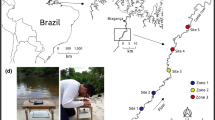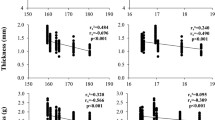Abstract
Jinjiang oyster Crassostrea ariakensis, a species with economic and ecological value, is distributed along the estuaries and coasts of East Asia. With the decline in natural resources, the conservation and aquaculture of this species is urgent. However, studies characterizing their shell shape remain scarce. We investigated the morphological differences in the shells of wild Jinjiang oysters from six populations (Qinzhou, Shanghai, Nantong, Qingdao, and Binzhou hard or muddy bottom) along the coast of China. The color of the shell and adductor muscle scar showed associations with temperature gradient along its geographical distribution. Oyster shape was defined by shell height to shell length ratio, and the ratio varies among geographic locations of the populations. They were found nearly round (Qinzhou and Nantong populations), oval (Qingdao and Binzhou populations), or water-droplet-shaped (Shanghai population). Binzhou populations living on muddy substrates are more elongated than those on hard substrate. In addition, we developed a method to measure the cavity volume in oysters. Correlation and path analysis showed that shell height significantly influenced cavity volume. The synergistic effect of the two factors (the height, length, and width of the shell in pairs) on the cavity volume resulted in differences between northern and southern groups: samples from the southern group (Qinzhou and Shanghai) showed correlation between shell height and shell width, while those from the northern group (Nantong, Qingdao, and Binzhou) showed correlation between shell height and shell length. All populations showed significant correlation between shell height and cavity height, and shell length and cavity length, while the correlation between shell width and cavity width was minimal, which may have been resulted from uneven shell thickness. The linear equation for shell height and cavity volume under different ratios of shell height to length was obtained. In this study, we determined that shell height has the most influence on cavity volume, and specific cavity volume fitting linear equations are given for different shell types, which may provide a reference for future oyster breeding for shell shaping.
Similar content being viewed by others
Data Availability Statement
The datasets generated during and/or analyzed during the current study are available from the corresponding author on reasonable request.
References
Ayvazian S, Gerber-Williams A, Grabbert S et al. 2020. Habitat benefits of restored oyster reefs and aquaculture to fish and invertebrates in a coastal pond in Rhode Island, United States. Journal of Shellfish Research, 39(3): 563–587, https://doi.org/10.2983/035.039.0306.
Chen J, Bai L R, Luo H et al. 2020. Correlation and path analysis of quantitative traits of pearl oyster Pinctada fucata at two different ages. Journal of Southern Agriculture, 51(10): 2557–2564, https://doi.org/10.3969/j.issn.2095-1191.2020.10.029. (in Chinese with English abstract)
Coen L D, Brumbaugh R D, Bushek D et al. 2007. Ecosystem services related to oyster restoration. Marine Ecology Progress Series, 341: 303–307, https://doi.org/10.3354/meps341303.
Coen L D, Luckenbach M W. 2000. Developing success criteria and goals for evaluating oyster reef restoration: ecological function or resource exploitation? Ecological Engineering, 15(3–4): 323–343, https://doi.org/10.1016/s0925-8574(00)00084-7.
Crosby M P, Gale L D. 1990. A review and evaluation of bivalve condition index methodologies with a suggested standard method. Journal of Shellfish Research, 9(1): 233–238.
Du Y J, Du J L, Liu X et al. 2021. Multiple-to-multiple path analysis model. PLoS One, 16(3): e0247722, https://doi.org/10.1371/journal.pone.0247722.
Fan C F, Pei Y D, Wang H et al. 2010. Relationship among the form, growth rate and living environment of oyster shells in west coast of Bohai Bay. Marine Science Bulletin, 29(5): 526–533. (in Chinese with English abstract)
Harding J M, Mann R. 2006. Age and growth of wild suminoe (Crassostrea ariakensis, Fugita 1913) and pacific (C. gigas, Thunberg 1793) oysters from Laizhou Bay, China. Journal of Shellfish Research, 25(1): 73–82, https://doi.org/10.2983/0730-8000(2006)25[73:AAGOWS]2.0.CO;2.
Huang S C, Hsieh H L, Chen C P. 2006. Effects of the winter Monsoon on the growth, mortality, and metabolism of adult oysters in Kinmen Island, Taiwan. Aquaculture, 251(2–4): 256–270, https://doi.org/10.1016/j.aquaculture.2005.05.026.
Ibarra A M. 1999. Correlated responses at age 5 months and 1 year for a number of growth traits to selection for total weight and shell width in catarina scallop (Argopecten ventricosus). Aquaculture, 175(3–4): 243–254, https://doi.org/10.1016/S0044-8486(99)00101-5.
Jiang W, Ma H Y, Ma C Y et al. 2014. Characteristics of growth traits and their effects on body weight of G1 individuals in the mud crab (Scylla paramamosain). Genetics and Molecular Research, 13(3): 6050–6059, https://doi.org/10.4238/2014.August.7.19.
Kim W J, Dammannagoda S T, Jung H et al. 2014. Mitochondrial DNA sequence analysis from multiple gene fragments reveals genetic heterogeneity of Crassostrea ariakensis in East Asia. Genes & Genomics, 36(5): 611–624, https://doi.org/10.1007/s13258-014-0198-5.
Kirby M X. 2000. Paleoecological differences between tertiary and quaternary crassostrea oysters, as revealed by stable isotope sclerochronology. Palaios, 15(2): 132–141, https://doi.org/10.1669/0883-1351(2000)015<0132:PDBTAQ>2.0.CO;2.
Krapivka S, Toro J E, Alcapán A C et al. 2007. Shell-shape variation along the latitudinal range of the Chilean blue mussel Mytilus chilensis (Hupe 1854). Aquaculture Research, 38(16): 1770–1777, https://doi.org/10.1111/j.1365-2109.2007.01839.X.
Lam K, Morton B. 2003. Mitochondrial DNA and morphological identification of a new species of Crassostrea (Bivalvia: Ostreidae) cultured for centuries in the Pearl River Delta, Hong Kong, China. Aquaculture, 228(1–4): 1–13, https://doi.org/10.1016/S0044-8486(03)00215-1.
Li A, Wang C G, Wang W et al. 2020. Molecular and fitness data reveal local adaptation of southern and northern estuarine oysters (Crassostrea ariakensis). Frontiers in Marine Science, 7: 589099, https://doi.org/10.3389/fmars.2020.589099.
Lin Q, Wang Y J, Wang D W et al. 2014. Comparison analysis of quantitative traits and path between two cultured populations of Crassostrea gigas and C. angulata. Marine Science Bulletin, 33(1): 106–111, https://doi.org/10.11840/j.issn.1001-6392.2014.01.014. (in Chinese with English abstract)
Liu W G, Lin J S, He M X. 2012. Path analysis of quantitative traits of scallop Chlamys nobilis at different ages. South China Fisheries Science, 8(1): 43–48, https://doi.org/10.3969/j.issn.2095-0780.2012.01.007. (in Chinese with English abstract)
Luo X, Ke C H, You W W. 2013. Estimates of correlations for shell morphological traits on body weight of interspecific hybrid abalone (Haliotis discus hannai and Haliotis gigantea). Journal of Shellfish Research, 32(1): 115–118, https://doi.org/10.2983/035.032.0117.
Ma H Y, Ma C Y, Ma L B et al. 2013. Correlation of growth-related traits and their effects on body weight of the mud crab (Scylla paramamosain). Genetics and Molecular Research, 12(4): 4127–4136, https://doi.org/10.4238/2013.October.1.3.
Mahon G A T. 1983. Selection goals in oyster breeding. Aquaculture, 33(1–4): 141–148, https://doi.org/10.1016/0044-8486(83)90395-2.
Massapina C, Joaquim S, Matias D et al. 1999. Oocyte and embryo quality in Crassostrea gigas (Portuguese strain) during a spawning period in Algarve, South Portugal. Aquatic Living Resources, 12(5): 327–333, https://doi.org/10.1016/s0990-7440(99)00115-1.
Mizuta D D, Wikfors G H. 2019. Seeking the perfect oyster shell: a brief review of current knowledge. Reviews in Aquaculture, 11(3): 586–602, https://doi.org/10.1111/raq.12247.
Peyer S M, Hermanson J C, Lee C E. 2010. Developmental plasticity of shell morphology of quagga mussels from shallow and deep-water habitats of the Great Lakes. Journal of Experimental Biology, 213(15): 2602–2609, https://doi.org/10.1242/jeb.042549.
Piehler M F, Smyth A R. 2011. Habitat-specific distinctions in estuarine denitrification affect both ecosystem function and services. Ecosphere, 2(1): 1–17, https://doi.org/10.1890/ES10-00082.1.
Ribeiro F M, Lima M, da Costa P A T et al. 2019. Associations between morphometric variables and weight and yields carcass in Pirapitinga Piaractus brachypomus. Aquaculture Research, 50(7): 2004–2011, https://doi.org/10.1111/are.14099.
Roper D S, Pridmore R D, Cummings V J et al. 1991. Pollution related differences in the condition cycles of pacific oysters Crassostrea gigas from Manukau Harbour, New Zealand. Marine Environmental Research, 31(3): 197–214, https://doi.org/10.1016/0141-1136(91)90011-V.
Seed R. 1968. Factors influencing shell shape in the mussel Mytilus edulis. Journal of the Marine Biological Association of the United Kingdom, 48(3): 561–584, https://doi.org/10.1017/S0025315400019159.
Solas M R, Sepúlveda R D, Brante A. 2013. Genetic variation of the shell morphology in Acanthina monodon (Gastropoda) in habitats with different wave eXposure conditions. Aquatic Biology, 18(3): 253–260, https://doi.org/10.3354/ab00508.
Sun Z W, Zheng H P, Yang Y H et al. 2010. Correlation and path analysis to quantitative traits for a cultured population of Jinjiang oyster Crassostrea hongkongensis. Chinese Agricultural Science Bulletin, 26(6): 332–336. (in Chinese with English abstract)
Toro J E, Newkirk G F. 1991. Response to artificial selection and realized heritability estimate for shell height in the Chilean oyster Ostrea chilensis. Aquatic Living Resources, 4(2): 101–108, https://doi.org/10.1051/alr:1991009.
Valladares A, Manríquez G, Suárez-Isla B A. 2010. Shell shape variation in populations of Mytilus chilensis (Hupe 1854) from southern Chile: a geometric morphometric approach. Marine Biology, 157(12): 2731–2738, https://doi.org/10.1007/s00227-010-1532-3.
Wang H Y, Guo X M, Zhang G F et al. 2004. Classification of Jinjiang oysters Crassostrea rivularis (Gould, 1861) from China, based on morphology and phylogenetic analysis. Aquaculture, 242(1–4): 137–155, https://doi.org/10.1016/j.aquaculture.2004.09.014.
Xiao J, Cordes J F, Wang H Y et al. 2010. Population genetics of Crassostrea ariakensis in Asia inferred from microsatellite markers. Marine Biology, 157(8): 1767–1781, https://doi.org/10.1007/s00227-010-1449-x.
Xiao S, Yu Z J, Fu Z N. 2011. Path analysis of quantitative traits of male and female Hong Kong oyster Crassostrea hongkongensis. South China Fisheries Science, 7(4): 1–9, https://doi.org/10.3969/j.issn.2095-0780.2011.04.001. (in Chinese with English abstract)
Xu F, Liu X, Zhang G F. 2007. Comparison of two methods to measure the internal shell cavity volume of oyster. Marine Science, 31(7): 15–19, https://doi.org/10.3969/j.issn.1000-3096.2007.07.004. (in Chinese with English abstract)
Xu Y, Tang Q Y, Xia Z L et al. 2020. Correlation between morphometric characteristics and meat yield of Macrobrachium rosenbergii (De Man, 1879) (Decapoda, Palaemonidae). Crustaceana, 93(9–10): 1169–1183, https://doi.org/10.1163/15685403-bja10069.
Yang H W, Huang H, Zhu J M et al. 2013. The measurement of bivalve mollusks’ internal shell cavity volume with the salt-displacement method. Environmental Science Survey, 32(5): 10–13, https://doi.org/10.13623/j.cnki.hkdk.2013.05.002. (in Chinese with English abstract)
Yokogawa K. 1998. Morphological variabilities and genetic features in Japanese common clam Ruditapes philippinarum. Japanese Journal of Malacology, 57(2): 121–132, https://doi.org/10.18941/venusjjm.57.2_121. (in Japanese with English abstract)
Zhang A G, Wang L L, Yang X L et al. 2018. Relationship between shell morphological traits and body weight in two estuarine clams, Meretrix meretrix and Cyclina sinensis in Shuangtaizi estuary, Bohai Sea in China. Journal of Shellfish Research, 37(5): 989–996, https://doi.org/10.2983/035.037.0509.
Zhao L Q, He Y Y, Yang F, et al. 2014. Correlation and path analysis of morphological and weight traits in marine gastropod Glossaulax reiniana. Chinese Journal of Oceanology and Limnology, 32(4): 821–827, https://doi.org/10.1007/s00343-014-3290-4.
Zhou M F, Allen S K Jr. 2003. A review of published work on Crassostrea ariakensis. Journal of Shellfish Research, 22(1): 1–20.
Acknowledgment
Thank Administration Agency of National Marine Garden of Haimen Liyashan for providing oysters from Nantong.
Author information
Authors and Affiliations
Corresponding authors
Additional information
Supported by the Key R&D Program Project of Shandong Province (No. 2021LZGC029), the Strategic Priority Research Program of the Chinese Academy of Sciences (No. XDA23050402), the Young Elite Scientists Sponsorship Program by China Association of Science and Technology (No. 2021QNRC001), the Technology and the Modern Agroindustry Technology Research System (No. CARS-49), the Innovation Capacity Improvement Project of Small and Medium-Sized Technology-Based Enterprise of Shandong Province (No. 2022TSGC1125), and the Key Technology Research and Industrialization Demonstration Projects of Qingdao, China (No. 22-3-3-hygg-2-hy)
Rights and permissions
About this article
Cite this article
Yang, Q., Li, A., Wang, L. et al. Shell characterization and effects on cavity volume of wild Jinjiang oyster Crassostrea ariakensis in different estuaries of China. J. Ocean. Limnol. 41, 2020–2031 (2023). https://doi.org/10.1007/s00343-022-2192-0
Received:
Accepted:
Published:
Issue Date:
DOI: https://doi.org/10.1007/s00343-022-2192-0




